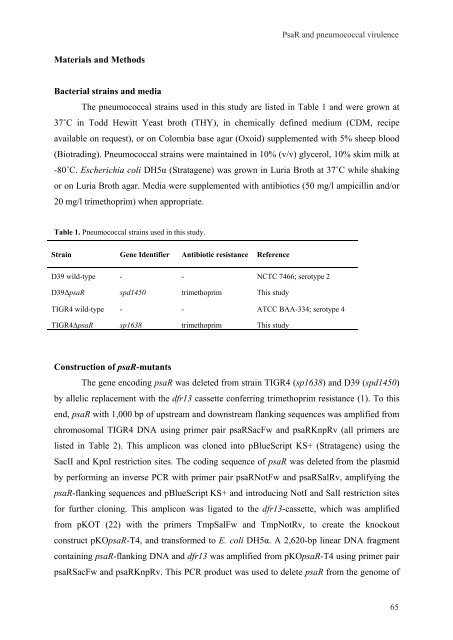Gene regulation in Streptococcus pneumoniae - RePub - Erasmus ...
Gene regulation in Streptococcus pneumoniae - RePub - Erasmus ...
Gene regulation in Streptococcus pneumoniae - RePub - Erasmus ...
You also want an ePaper? Increase the reach of your titles
YUMPU automatically turns print PDFs into web optimized ePapers that Google loves.
Materials and Methods<br />
Bacterial stra<strong>in</strong>s and media<br />
The pneumococcal stra<strong>in</strong>s used <strong>in</strong> this study are listed <strong>in</strong> Table 1 and were grown at<br />
37�C <strong>in</strong> Todd Hewitt Yeast broth (THY), <strong>in</strong> chemically def<strong>in</strong>ed medium (CDM, recipe<br />
available on request), or on Colombia base agar (Oxoid) supplemented with 5% sheep blood<br />
(Biotrad<strong>in</strong>g). Pneumococcal stra<strong>in</strong>s were ma<strong>in</strong>ta<strong>in</strong>ed <strong>in</strong> 10% (v/v) glycerol, 10% skim milk at<br />
-80�C. Escherichia coli DH5α (Stratagene) was grown <strong>in</strong> Luria Broth at 37�C while shak<strong>in</strong>g<br />
or on Luria Broth agar. Media were supplemented with antibiotics (50 mg/l ampicill<strong>in</strong> and/or<br />
20 mg/l trimethoprim) when appropriate.<br />
Table 1. Pneumococcal stra<strong>in</strong>s used <strong>in</strong> this study.<br />
Stra<strong>in</strong> <strong>Gene</strong> Identifier Antibiotic resistance Reference<br />
D39 wild-type - - NCTC 7466; serotype 2<br />
D39ΔpsaR spd1450 trimethoprim This study<br />
TIGR4 wild-type - - ATCC BAA-334; serotype 4<br />
TIGR4ΔpsaR sp1638 trimethoprim This study<br />
PsaR and pneumococcal virulence<br />
Construction of psaR-mutants<br />
The gene encod<strong>in</strong>g psaR was deleted from stra<strong>in</strong> TIGR4 (sp1638) and D39 (spd1450)<br />
by allelic replacement with the dfr13 cassette conferr<strong>in</strong>g trimethoprim resistance (1). To this<br />
end, psaR with 1,000 bp of upstream and downstream flank<strong>in</strong>g sequences was amplified from<br />
chromosomal TIGR4 DNA us<strong>in</strong>g primer pair psaRSacFw and psaRKnpRv (all primers are<br />
listed <strong>in</strong> Table 2). This amplicon was cloned <strong>in</strong>to pBlueScript KS+ (Stratagene) us<strong>in</strong>g the<br />
SacII and KpnI restriction sites. The cod<strong>in</strong>g sequence of psaR was deleted from the plasmid<br />
by perform<strong>in</strong>g an <strong>in</strong>verse PCR with primer pair psaRNotFw and psaRSalRv, amplify<strong>in</strong>g the<br />
psaR-flank<strong>in</strong>g sequences and pBlueScript KS+ and <strong>in</strong>troduc<strong>in</strong>g NotI and SalI restriction sites<br />
for further clon<strong>in</strong>g. This amplicon was ligated to the dfr13-cassette, which was amplified<br />
from pKOT (22) with the primers TmpSalFw and TmpNotRv, to create the knockout<br />
construct pKOpsaR-T4, and transformed to E. coli DH5α. A 2,620-bp l<strong>in</strong>ear DNA fragment<br />
conta<strong>in</strong><strong>in</strong>g psaR-flank<strong>in</strong>g DNA and dfr13 was amplified from pKOpsaR-T4 us<strong>in</strong>g primer pair<br />
psaRSacFw and psaRKnpRv. This PCR product was used to delete psaR from the genome of<br />
65<br />
65

















